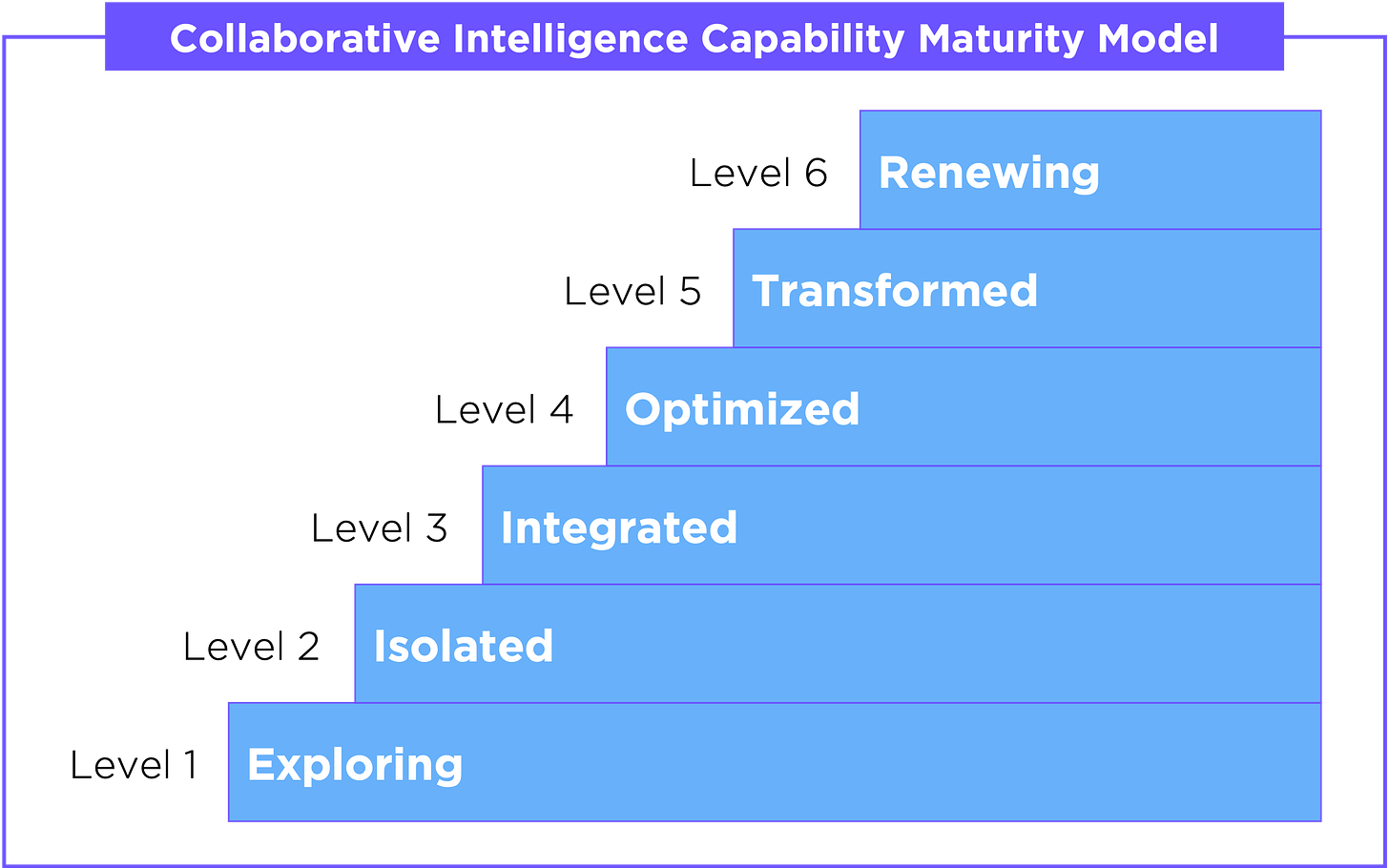A Capability Maturity Model for Collaborative Intelligence
I would like to thank my friend and colleague Gezinus Hidding for his thoughts and feedback on this model as it was being developed.
In a recent post, I categorized completing a collaborative intelligence-enabled transformation as “A Hero’s Journey” for business leaders. But what specific steps are required to complete this journey successfully?
I recommend using a Capability Maturity Model (CMM) as a guide. A CMM framework helps organizations assess the maturity of distinct business components and improve them systematically and progressively.
I'm a big fan of capability maturity models. I was introduced to them in 1993 when the Software Engineering Institute (SEI) released its Capability Maturity Model for Software. The authors’ approach influenced my thinking about process design at a time when I was heavily involved in reengineering.
Inspired by their work, I have developed capability maturity models for business process redesign, enterprise portfolio management, and innovation management. I have applied these models to help many clients improve their capabilities in these areas. Each of these improvements resulted in better operational and financial performance.
The rise of AI has led to many conversations with business leaders about what it will take for their organizations to move from AI explorations to the development of collaborative intelligence (CI) capabilities that will create shareholder value and strengthen competitive positions. In response, I have developed a capability maturity model for CI (Figure 1).
Capability Maturity Model Components
This model examines the following components to determine the appropriate maturity level of CI use within the organization:
Organizational awareness/knowledge of CI technologies
Depth/Breadth of CI-related skills/experience
Existence of and adherence to CI-specific skills management process
Extent to which business strategy is influenced by or reflects the prospective impacts of CI
Depth/Breadth of CI technologies deployed
Depth/Breadth of CI-enabled business processes
Depth/Breadth of CI-enabled products/services
Breadth/Effectiveness of CI-aware management processes and metrics
Existence/Effectiveness of CI-related governance processes and policies
Ability of data management processes/architectures to support the development and scaling of CI systems
Ability of computing/networking/cybersecurity infrastructure to support the secure, scalable, and efficient development, deployment, and operation of CI systems
Degree to which job designs and team structure/composition reflect and enable efficient collaboration with intelligent machines
Degree to which the organizational culture supports and creates incentives for the values and behaviors required for humans and intelligent machines to collaborate efficiently and effectively
The Collaborative Intelligence Capability Maturity Model (CI-CMM)
This article provides an overview of the model by briefly summarizing each maturity level. I will write a series of articles that provide more detail about the observable characteristics at each level, describe how to assess maturity at each level, and present strategies and actions to achieve higher maturity.
Please note two things:
A CMM describes a state of maturity. It does not describe how organizations achieved such a state (that’s the purpose of the additional articles).
A company can exhibit specific characteristics of higher maturity levels. Still, until all (or almost all) components in the model’s purview exhibit the characteristics required of that level, the company will remain at a lower maturity level.
Level 1: Exploring
Companies at this maturity level have limited awareness of the categories and capabilities of CI technologies and are still determining their business value. Most uses of CI within the company are grass-roots explorations by individuals or ad hoc groups, with little or no coordination and no standardization of approach. The uses tend to be limited in scope, and any value produced for an individual or group is often difficult to replicate across the organization.
Level 2: Isolated
Companies at this maturity level have deployed one or more CI applications (such as a customer service chatbot or a limited content generation system), but these applications are isolated and may not be scaled or extended easily. They have most often been “bolted on” to existing business processes without regard to how CI-enabled processes might be redesigned or reimagined.
Level 3: Integrated
Companies at this maturity level have used CI technologies to redesign several key business processes, with all demonstrating improved performance. Each of the redesigns is aligned with organizational goals and managed using formal project and portfolio management processes that enforce evolving CI policies. Each solution is architected to be scalable and extensible.
Level 4: Optimized
Companies at this maturity level have CI integrated into core business processes and are using quantitative techniques to measure and improve CI system performance. Robust metrics and KPIs assess CI-enabled organizational performance, and robust systems and data management infrastructures are in place. Resource-intensive applications have been moved to a private cloud to reduce operating costs. Comprehensive financial and risk management processes have been established for all CI initiatives. Advanced portfolio management techniques optimize strategic and economic value while minimizing risk.
Level 5: Transformed
Companies at this maturity level have transformed into CI-enabled organizations. CI is deployed strategically across the organization, driving improved insights and decision-making, significant performance improvements, and process and business model innovations. Cultural norms and behaviors embrace AI and other forms of machine intelligence because leaders have demonstrated that these technologies do not threaten employees’ jobs or their agency.
Level 6: Renewing
The power and capabilities of collaborative technologies are growing rapidly, and the number of CI categories is expanding quickly. Thus, once a company has achieved a successful CI-enabled transformation, it must continually renew itself by expanding and extending its use of CI.
Companies at this maturity level actively explore and experiment with next-generation CI technologies and their applications. They form strategic partnerships with vendors, research institutions, and startups to stay at the forefront of CI advancements. They demonstrate sustained leadership in CI innovation, setting industry standards and driving best practices. They are agile and adaptable, ready to embrace and integrate new technologies and methodologies quickly.
Collaborative Intelligence is a Transformativ, LLC publication. If you’d like to learn more about how to become an AI-powered enterprise, please contact us here.




